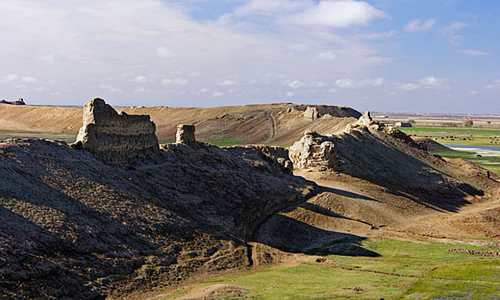Behold Shamis en Balkh, also known as Sams-i-Bala, the Elevated Candle, revered as the Mother of All Cities, and historically recognized as Bactra.
These remnants reveal a fragment of the outer walls encircling the ancient city of Balkh, spanning a circumference of seven miles. Located at 67E, 36N, Balkh, also known as Bactra, once housed the impressive Kal’ah, a castle arranged akin to Herodotus’ description of Ekbatana – concentric walls ascending toward the central hill crowned by the Great Palace.
Historical accounts highlight Balkh as a stronghold for Afghan-Sufi-Buddhists, with the Nava Vihara Monastery at its core. This sacred space, influenced by esoteric Sufi-Buddhist-Zoroastrian teachings, coexisted with diverse doctrines. Entry for Buddhists was contingent upon presenting a written paper on Buddhism, and the Nava Vihara Monastery, constructed on an old Zoroastrian fire-temple, featured temples resembling cubes, reminiscent of the Kaaba in Mecca.
In 630, Xuanzang’s Memoirs depict Balkh as a thriving hub with a hundred Buddhist monasteries, 30,000 monks, and numerous stupas. The city shared strong connections with the Kingdom of Khotan in the Tarim Basin, led by Kashmiris known as Pramukh or the Barmakids under Arabized names.
Balkh, existing for 2,500 years, witnessed the rise and fall of conquerors, earning the title “Umm-al-belad” or the mother of cities from the Arabs. Despite the devastation inflicted by Genghis Khan, Balkh never fully recovered.
Strategically situated, Balkh intersected natural trade routes, connecting caravans to Herat, Iran, Samarkand, and China. The Balkab valley facilitated passage to Bamiyan and Kabul. The city’s greatness stemmed not only from geographical advantages but also from its people, fostering craftsmanship, trade, and cultural contributions across the Iranian world. However, Balkh, usually affluent but not militarily powerful, often became the coveted prize of more warlike neighbors.
Through shifting rulers and numerous sackings, Balkh endured. Under Samanid rule, it thrived as a prosperous city of mud brick, housing a diverse population of Persians, Turks, Jews, and Indian traders. The city nurtured poets, scholars, lawyers, and various intellectuals. Yet, peace remained elusive, with nomadic threats persisting even during Seljuk rule.

